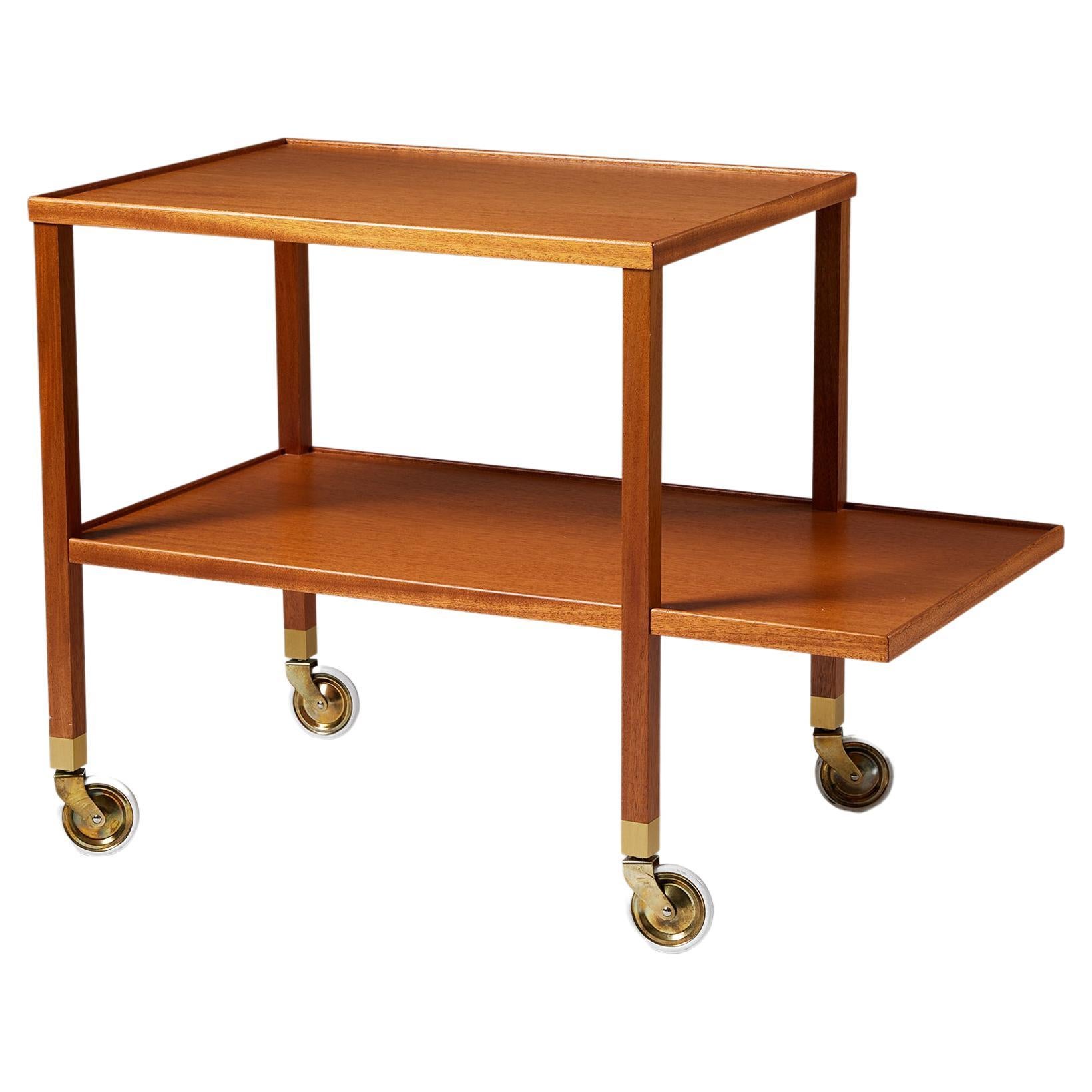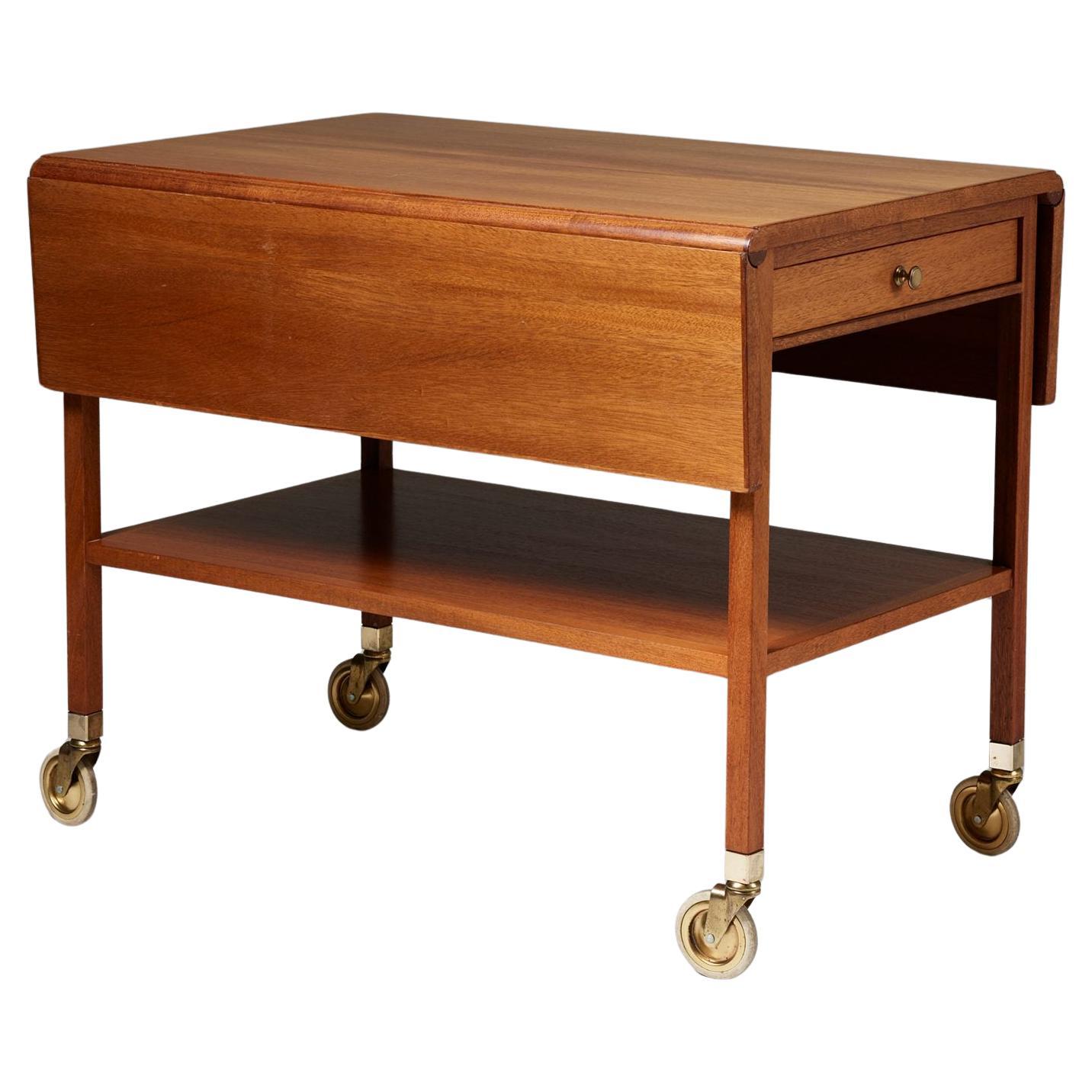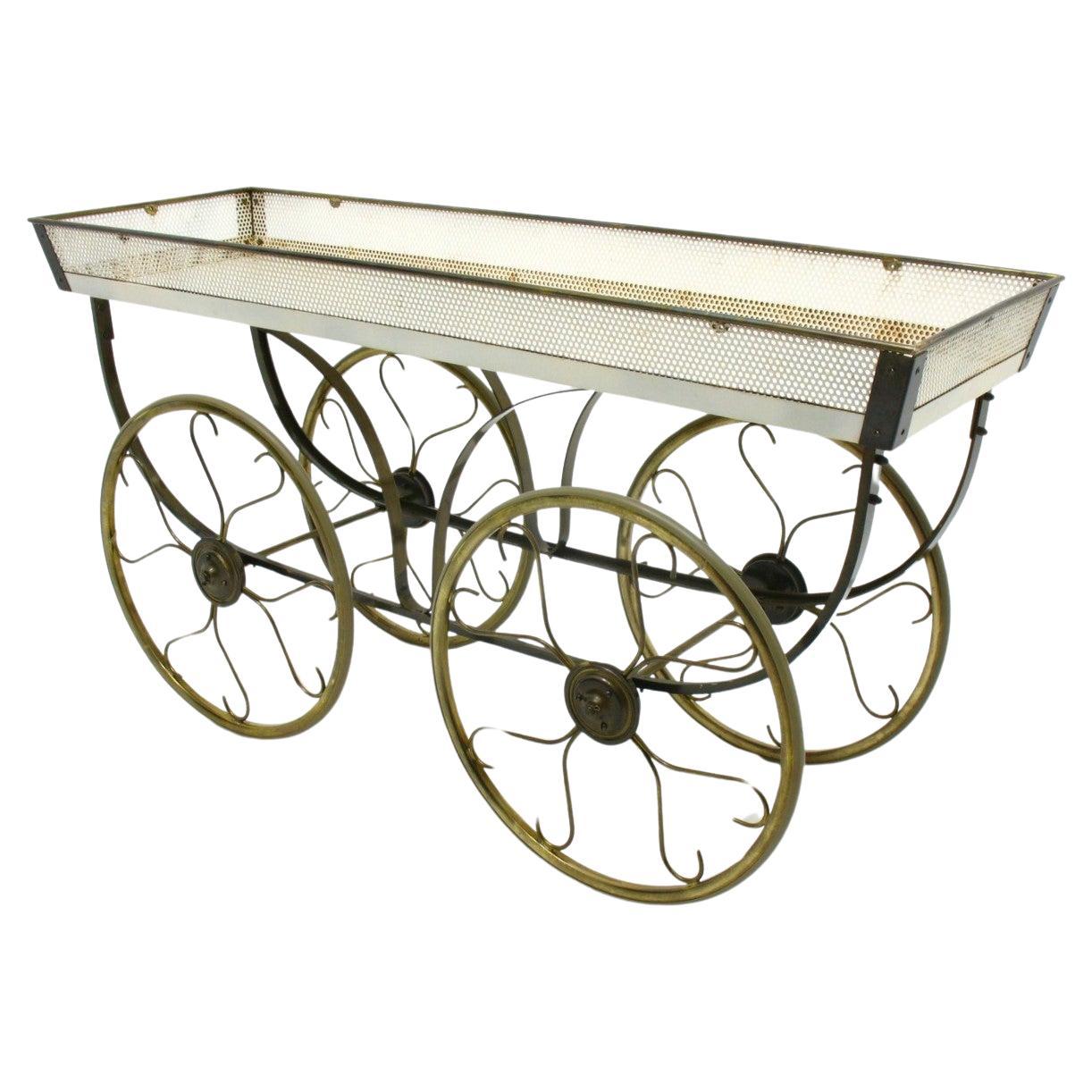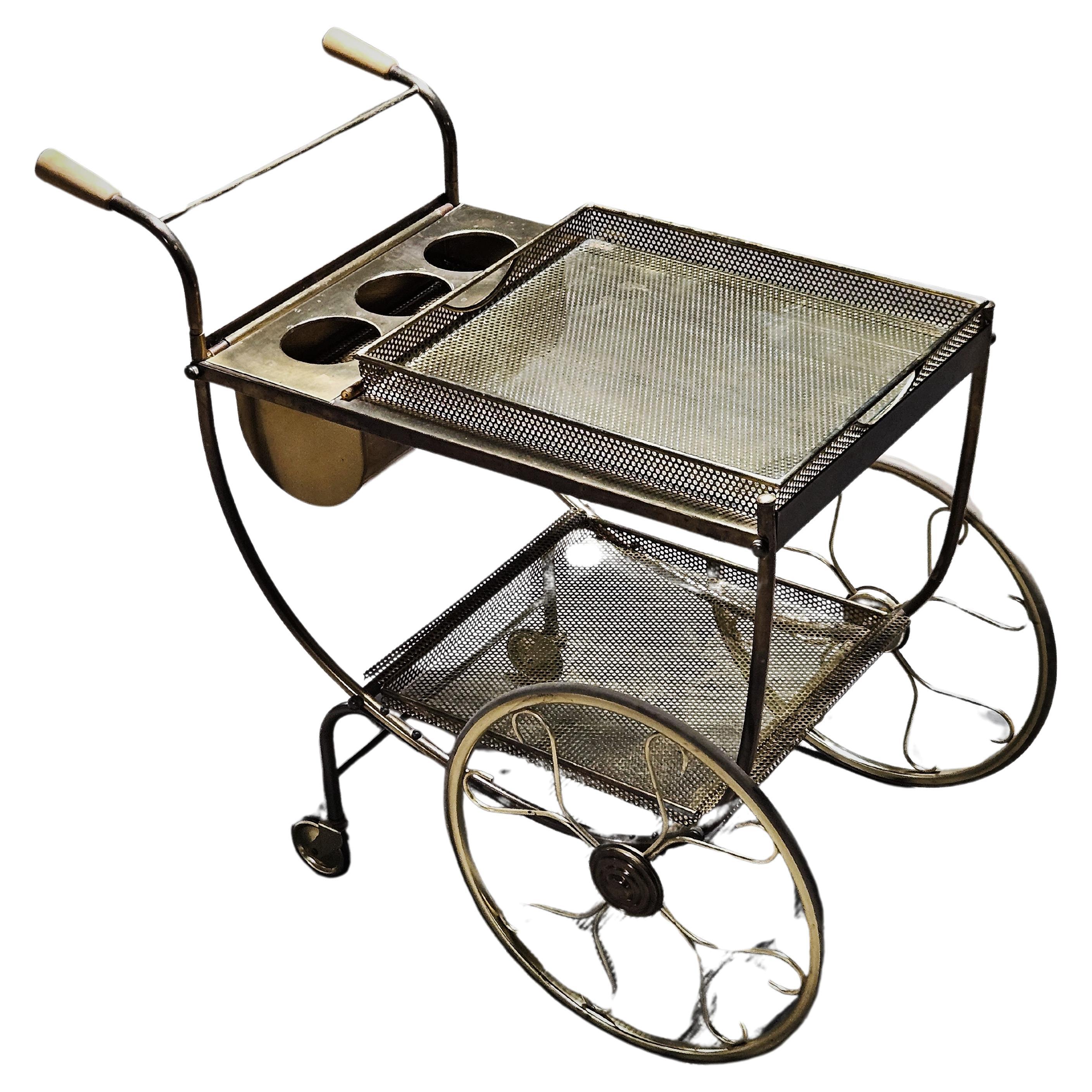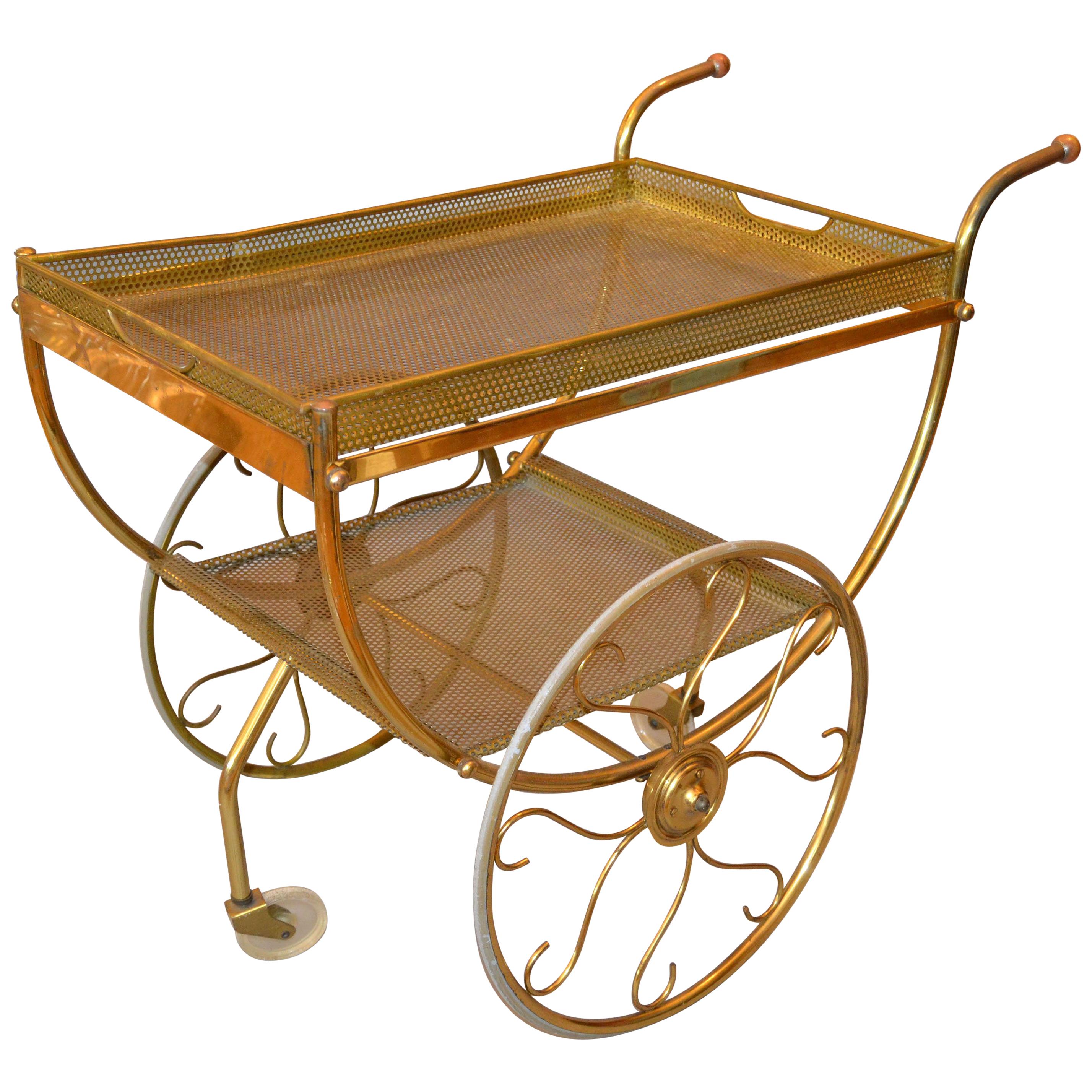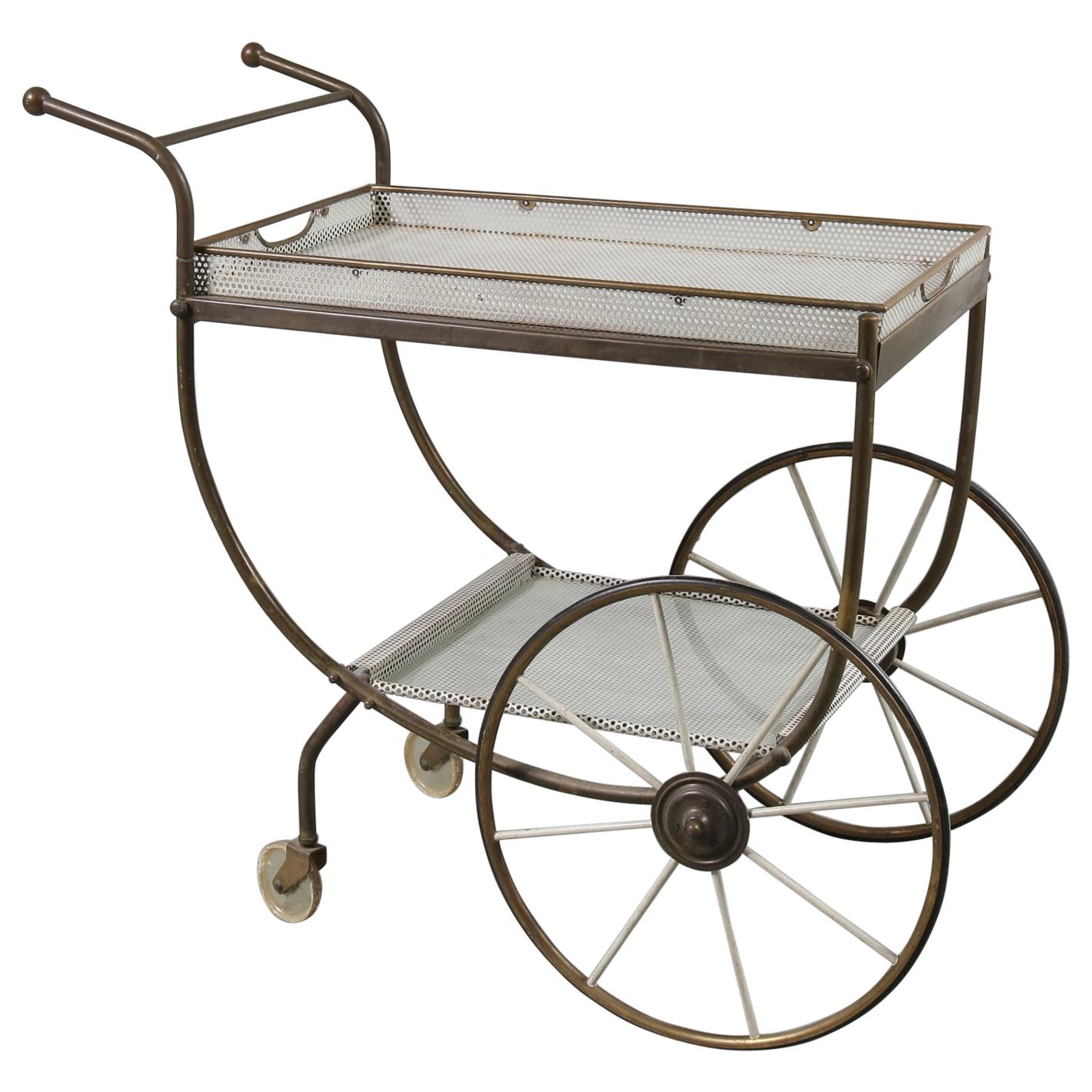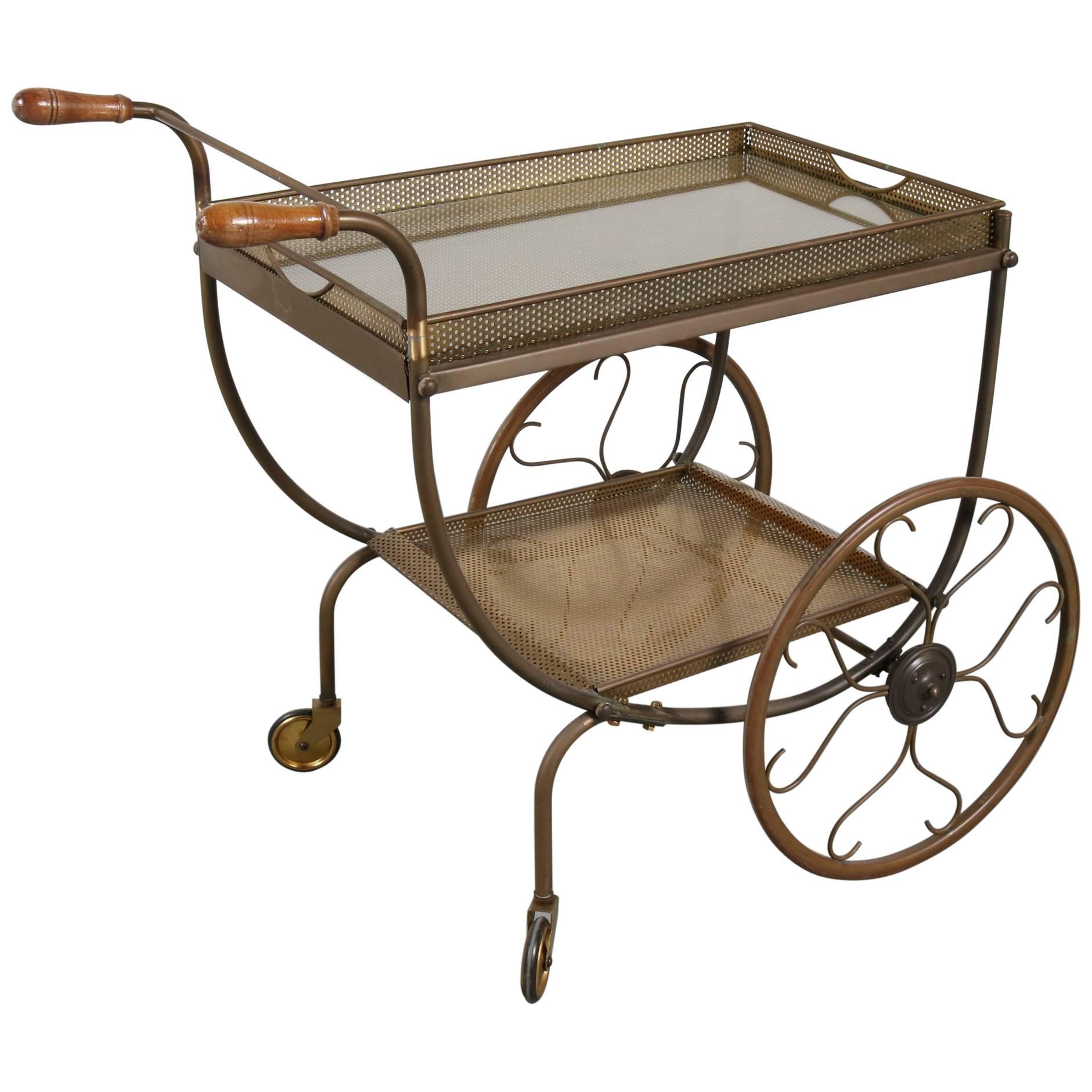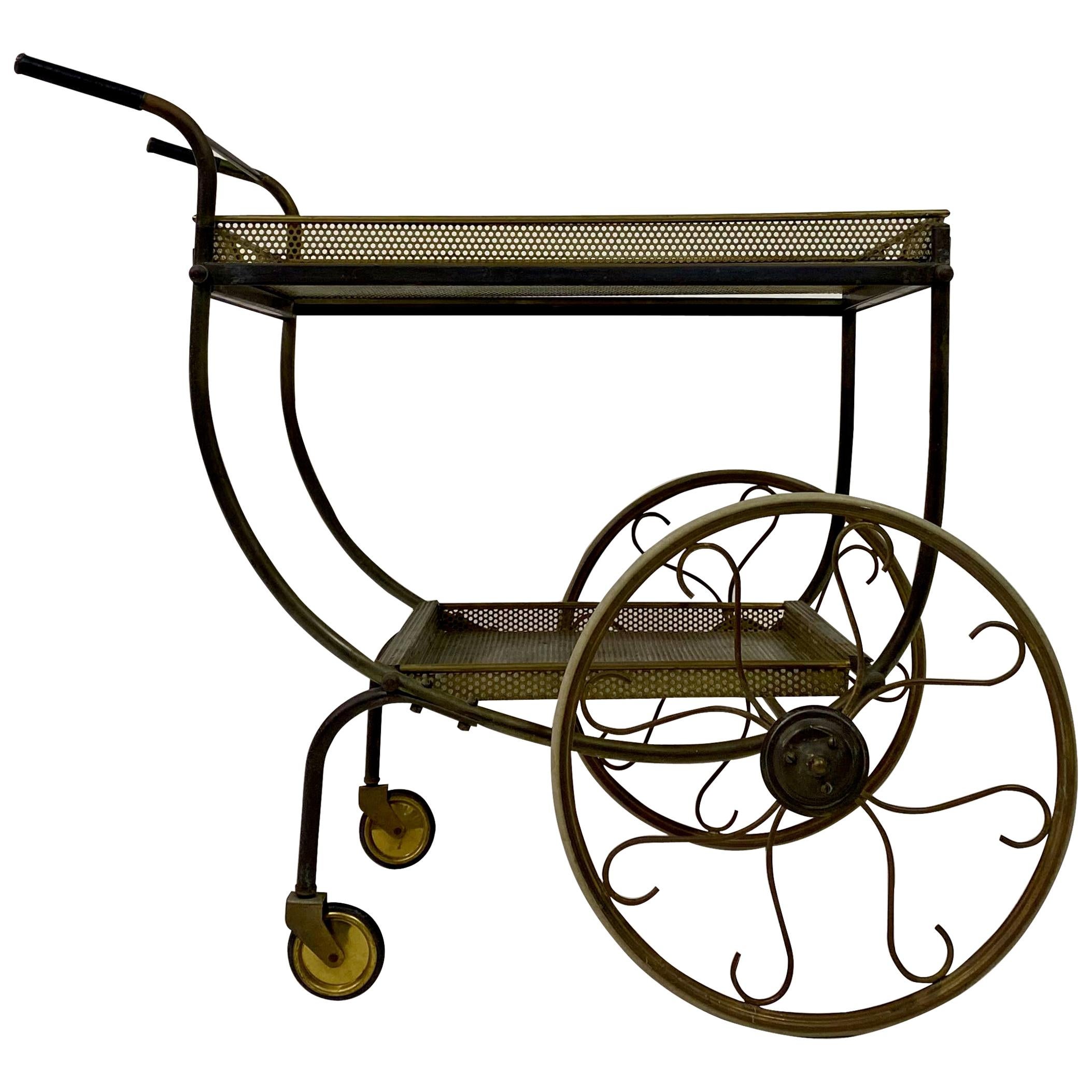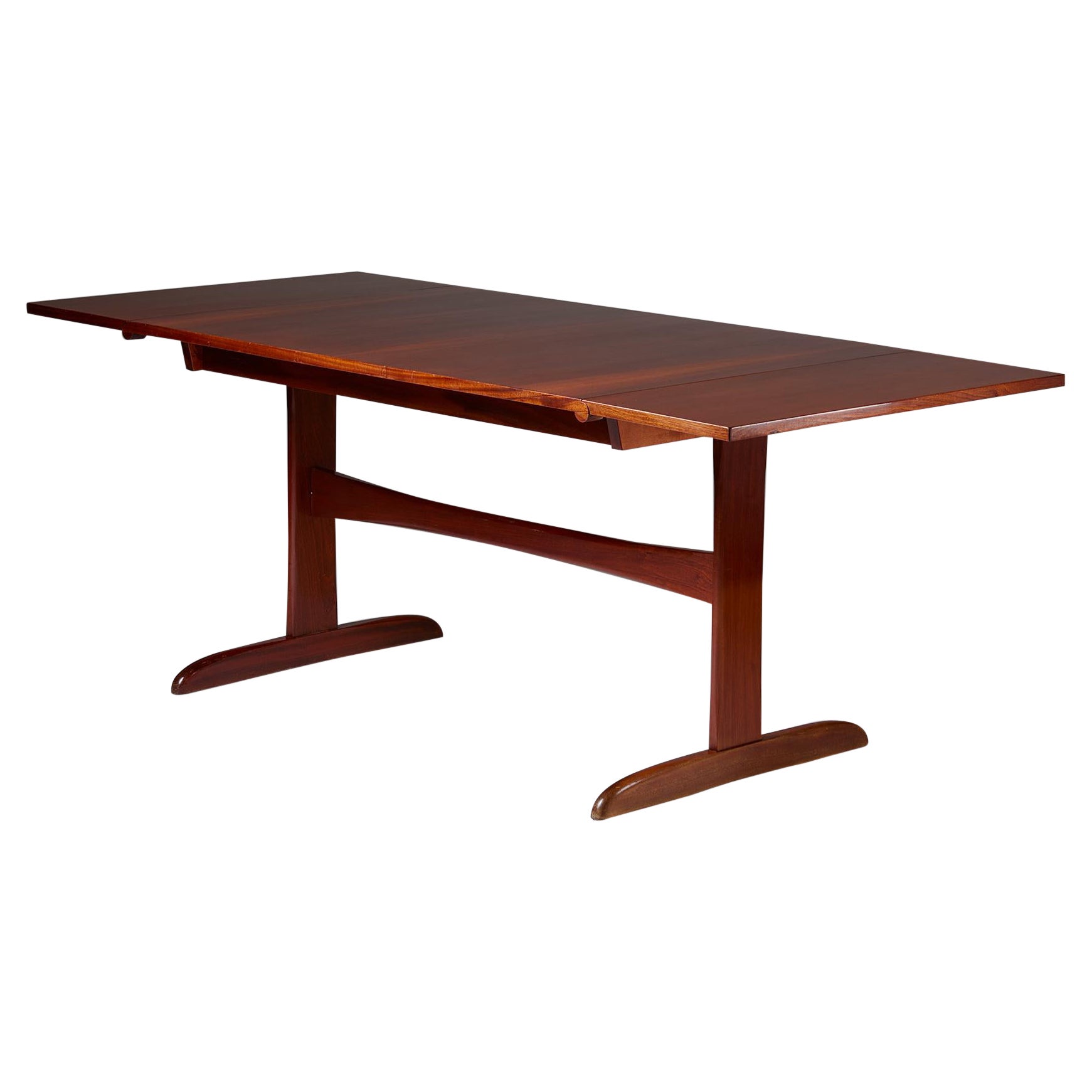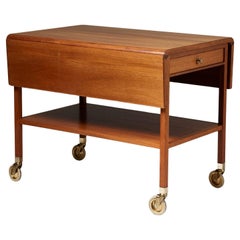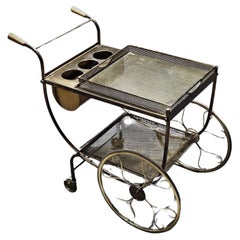
Tea Trolley Designed by Josef Frank for Svenskt Tenn, Sweden, 1940s
View Similar Items
Tea Trolley Designed by Josef Frank for Svenskt Tenn, Sweden, 1940s
About the Item
- Creator:Josef Frank (Designer)
- Dimensions:Height: 22.45 in (57 cm)Width: 33.08 in (84 cm)Depth: 18.51 in (47 cm)
- Style:Scandinavian Modern (Of the Period)
- Materials and Techniques:
- Place of Origin:
- Period:
- Date of Manufacture:1940s
- Condition:
- Seller Location:Stockholm, SE
- Reference Number:1stDibs: LU1006618648382
Josef Frank
Austrian architect and furniture and fabric designer Josef Frank was a leading voice for a gentle, humane modernism. His advocacy of warm, comfortable, eclectically styled environments was highly influential in his adopted country of Sweden, and it’s now widely regarded as a harbinger of the backlash against doctrinaire modernism and the embrace of the homespun that occurred in the late 1960s.
The son of a successful Viennese textile manufacturer, Frank studied architecture at Vienna University of Technology, graduating in 1910. From the first years of his practice, he marched counter to the orderly, symmetrical architectural layouts and decors prescribed by contemporaries such as Adolf Loos.
Frank drafted rooms of varying shapes and called for flexible interior-design arrangements. His furniture pieces are light and easy to move — and his chairs are always made of wood, most often with lushly curved steam-bent arms and slatted backs. Frank openly loathed the tubular steel furnishings and “machine for living” aesthetic promoted by Le Corbusier and Ludwig Mies van der Rohe and other Bauhaus principals. “The home must not be a mere efficient machine,” Frank once said. “It must offer comfort, rest and coziness…. There are no puritan principles in good interior decoration.”
Frank — who was Jewish — sensed the dire implications of the rise of Nazism in Germany and Austria, and in 1933 he moved to Stockholm with his Swedish wife, Anna. He became the design chief for the furnishings maker Svenskt Tenn and found a perfect match culturally for his brand of simple, relaxed and bright creations. Like many modernists — notably Charles and Ray Eames and Alexander Girard — Frank had a deep love of folk art, which influenced his designs for a wide array of colorful, richly patterned upholstery fabrics, many based on the classic “Tree of Life” motif.
In all his designs, Frank took inspiration from a broad variety of sources. In his furniture, one can discern traces of Asian patterns, Rococo, Italian Renaissance, Scandinavian handicrafts and even Chippendale pieces. As such, the work of Frank — the friendly modernist — is at home in any type of décor.
Find vintage Josef Frank pillows, armchairs, floor lamps and other furniture on 1stDibs.
- Serving Trolley Model 470 Designed by Josef Frank for Svenskt Tenn, Sweden, 1950By Josef FrankLocated in Stockholm, SEServing trolley model 470 designed by Josef Frank for Svenskt Tenn, Sweden, 1950s. Mahogany. Stamped. H: 60 cm W: 80 cm D: 45 cm Josef Frank was a true European, he was also a pi...Category
Mid-20th Century Swedish Mid-Century Modern Carts and Bar Carts
MaterialsMahogany
- Walnut and Brass Serving Trolley Model 756 by Josef Frank for Svenskt Tenn 1940sBy Josef FrankLocated in Stockholm, SEServing trolley model 756 designed by Josef Frank for Svenskt Tenn, Sweden, 1940s. Veneered walnut and brass. H: 65 cm W: 53 cm Width when fully extended: 89 cm D: 80 cm Josef Fr...Category
Mid-20th Century Swedish Mid-Century Modern Carts and Bar Carts
MaterialsBrass
- Dining Table Model 1197 Designed by Josef Frank for Svenskt Tenn, Sweden, 1940sBy Josef FrankLocated in Stockholm, SEDining table model 1197 designed by Josef Frank for Svenskt Tenn, Sweden, 1940s. Mahogany. This simple yet elegant dining table is an excellent example of how Josef Frank combined...Category
Mid-20th Century Swedish Mid-Century Modern Dining Room Tables
MaterialsMahogany
- Occasional Table Designed by Josef Frank for Svenskt Tenn, Sweden, 1950sBy Josef FrankLocated in Stockholm, SEOccasional table designed by Josef Frank for Svenskt Tenn, Sweden, 1950s. Mahogany. Measurements: H: 60 cm/ 23 1/2'' Length when extened: 104 cm/ 3' 5'' D: 54 cm/ 21 1/2'' Jose...Category
Vintage 1950s Swedish Scandinavian Modern Side Tables
MaterialsMahogany
- Occasional Table Designed by Josef Frank for Svenskt Tenn, Sweden, 1950sBy Josef FrankLocated in Stockholm, SEOccasional table designed by Josef Frank for Svenskt Tenn, Sweden. 1950s. Mahogany. H: 45 cm L: 80 cm D: 40 cm Josef Frank was a true European, he was also a pioneer of what would become classic 20th century Swedish design and the “Scandinavian Design Style”. Austrian- born Frank started his design career as an architect after having trained at the Technische Hochschule in Vienna between 1903 and 1910. After his training he went on to teach at Kunstgewerbeschule (The Viennese School of Arts and crafts) where he developed and espoused the new school of modernist thinking towards Architecture and Design that was coming to fruition in Vienna at the time. He also went on to lead the Vienna Werkbund throughout the 1920s. This was a truly progressive group of Architects and Designers who set about improving the daily lives of Austrian people through modernist design and architecture in partnership with Arts and Crafts ideals and construction. Frank’s leadership of the Werkbund had already cemented his place at the forefront of European design. Frank’s time in Vienna was typified by his design for the “Die Wohnung” exhibition of the Deutscher Werkbund in Stuttgart, 1927 where he exhibited along side his contemporaries at the forefront of design, such as the likes of Le Corbusier and Walter Gropius. Here he showed a specially designed pair of flat-roofed reinforced concrete houses in what is now seen as a typical modernist style. What separated Frank’s house from the other 32 houses of the exhibition was the interior and furniture inside the building. It was described as “Neo-Classical” and filled with an eclectic mix of period pieces, modern design and pieces designed by Frank himself that seemed to cross the two worlds. This was a complete opposite direction to that which his fellow Architects were travelling in with their pared back and angular aesthetics. Frank said of his own work: “The house is not a work of art, simply a place where one lives,” and by this reasoning Frank rejected the regimental mechanisation of the living space that his contemporaries believed in, instead he set about creating congenial and spontaneous interiors. Frank’s practice saw him placing the bright colours and the soft forms of nature back into the furnishings and interiors that he thought modernism sorely mist. Frank, along with Oskar Walch set up Haus und Garten in Vienna in 1925. This was Frank’s first commercial foray into furniture and home furnishings and the company went on to become the most influential furnishing house in Vienna with a riotous depth of colour and interesting shapes becoming the trademark of their design. However this success was to come to an end with rise of Nazism in Vienna in the early 1930’s. Frank was Jewish, and he and his wife Anna decided they would leave Vienna for her motherland: Sweden, in 1933. Frank continued to design for Haus and Garten, visiting Vienna occasionally and designing the pieces that would continue to be the company’s best...Category
Vintage 1950s Swedish Scandinavian Modern Tables
MaterialsMahogany
- Table lamp model 2552 designed by Josef Frank for Svenskt Tenn, Sweden. 1950sBy Josef FrankLocated in Stockholm, SEBrass. Table Lamp Model 2552 Designed by Josef Frank for Svenskt Tenn, Sweden, 1950s Measures: H 49.5 cm Josef Frank was a true European, he was also a pioneer of what would become classic 20th century Swedish design and the “Scandinavian Design Style”. Austrian- born Frank started his design career as an architect after having trained at the Technische Hochschule in Vienna between 1903 and 1910. After his training he went on to teach at Kunstgewerbeschule (The Viennese School of Arts and crafts) where he developed and espoused the new school of modernist thinking towards Architecture and Design that was coming to fruition in Vienna at the time. He also went on to lead the Vienna Werkbund throughout the 1920s. This was a truly progressive group of Architects and Designers who set about improving the daily lives of Austrian people through modernist design and architecture in partnership with Arts and Crafts ideals and construction. Frank’s leadership of the Werkbund had already cemented his place at the forefront of European design. Frank’s time in Vienna was typified by his design for the “Die Wohnung” exhibition of the Deutscher Werkbund in Stuttgart, 1927 where he exhibited along side his contemporaries at the forefront of design, such as the likes of Le Corbusier and Walter Gropius. Here he showed a specially designed pair of flat-roofed reinforced concrete houses in what is now seen as a typical modernist style. What separated Frank’s house from the other 32 houses of the exhibition was the interior and furniture inside the building. It was described as “Neo-Classical” and filled with an eclectic mix of period pieces, modern design and pieces designed by Frank himself that seemed to cross the two worlds. This was a complete opposite direction to that which his fellow Architects were travelling in with their pared back and angular aesthetics. Frank said of his own work: “The house is not a work of art, simply a place where one lives,” and by this reasoning Frank rejected the regimental mechanisation of the living space that his contemporaries believed in, instead he set about creating congenial and spontaneous interiors. Frank’s practice saw him placing the bright colours and the soft forms of nature back into the furnishings and interiors that he thought modernism sorely mist. Frank, along with Oskar Walch set up Haus und Garten in Vienna in 1925. This was Frank’s first commercial foray into furniture and home furnishings and the company went on to become the most influential furnishing house in Vienna with a riotous depth of colour and interesting shapes becoming the trademark of their design. However this success was to come to an end with rise of Nazism in Vienna in the early 1930’s. Frank was Jewish, and he and his wife Anna decided they would leave Vienna for her motherland: Sweden, in 1933. Frank continued to design for Haus and Garten, visiting Vienna occasionally and designing the pieces that would continue to be the company’s best...Category
Vintage 1950s Swedish Scandinavian Modern Table Lamps
MaterialsBrass
- Swedish Tea or Bar Cart by Josef Frank for Svenskt Tenn, 1950sBy Svenskt Tenn, Josef FrankLocated in Matosinhos, 13A beautiful design piece, imagined by Josef Frank for the Swedish brand Svenskt Tenn in the 1950s. This piece can be used as a bar or tea cart, infusing any space with glamour and ch...Category
Vintage 1950s Swedish Carts and Bar Carts
MaterialsBrass, Sheet Metal
- Bar cart by Josef Frank, Svenskt tenn, Sweden, 1950sBy Josef Frank, Svenskt TennLocated in Eskilstuna, SEClassic bar cart produced by Svenskt tenn and designed by Josef Frank in the 1950s. Made in brass, glass and wooden handles. Removable tray with handles. This model is a rare one w...Category
Mid-20th Century Swedish Scandinavian Modern Carts and Bar Carts
MaterialsBrass
- Svenskt Tenn Mid century Modern Brass Service Trolley by Josef FrankBy Josef FrankLocated in Weesp, NLMid ccnetury modern brass Svenskt Tenn service trolley by Josef Frank An absolutely elegant and stylish Mid-Century bar cart by Swedish design company Svenskt Tenn, circa 1950s. Made of tubular and perforated brass in great vintage condition. The removable carry tray makes it perfect for entertaining by serving cocktails or tea and coffee in the morning. Trolley will be shipped to the US in a custom-made crate. Cost of transport crate included is Euro 495 Josef Frank studied architecture at the Vienna University of Technology. He then taught at the Vienna School of Arts and Crafts from 1919 to 1925. He was a founding member of the Vienna Werkbund, initiator and leader of the 1932 project Werkbundsiedlung in Vienna. In 1933, he emigrated to Sweden, where he gained citizenship in 1939. He was the most prestigious designer in the Stockholm design company Svenskt Tenn (Swedish Pewter). He remained in Sweden after 1945 despite attempts to return him to Vienna. The Vienna Circle...Category
Mid-20th Century Swedish Mid-Century Modern Carts and Bar Carts
MaterialsBrass
- Scandinavian Modern Brass Acrylic Bar Cart Josef Frank for Svenskt Tenn SwedenBy Josef Frank, Svenskt TennLocated in Miami, FLChic 1950s Scandinavian modern brass bar cart designed by Josef Frank and manufactured for Svenskt Tenn in Sweden. Made out of tubular and perforated brass. Wire mesh brass tray on ...Category
Vintage 1950s Swedish Scandinavian Modern Carts and Bar Carts
MaterialsBrass
- Tea Trolley by Svenskt Tenn, Sweden, 1950By Svenskt TennLocated in Amsterdam, NLLuxurious tea trolley bar cart, manufactured in Sweden by Svenskt Tenn, circa 1950. This elegant piece is made of beautiful quality brass, giving it a very classy appearance. It s...Category
Late 20th Century Danish Mid-Century Modern Carts and Bar Carts
MaterialsBrass, Metal
- Tea Trolley by Svenskt Tenn, Sweden, 1950By Svenskt TennLocated in Amsterdam, NLLuxurious tea trolley bar cart, manufactured in Sweden by Svenskt Tenn, circa 1950. This elegant piece is made of beautiful quality brass, giving it beautiful classy appearance. I...Category
Late 20th Century Danish Mid-Century Modern Carts and Bar Carts
MaterialsBrass
